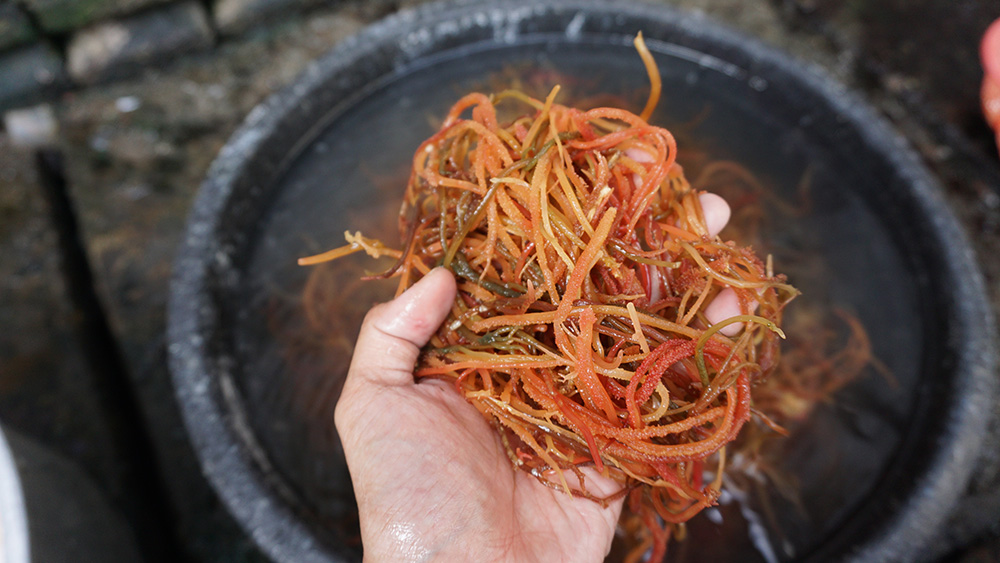Like clothes, supplements come in and out of fashion. Remember when coconut oil was solving all our problems? I’m currently hearing a lot of buzz about sea moss. Social media influencers are spooning it into their smoothies and singing its praises for smooth, glowing skin. So, is this the skin saviour you’ve been waiting for? Read on to find out more.
What is sea moss?
Sea moss (Chondrus Crispus) is also known as Irish Moss or red seaweed. It is a seaweed found along the Atlantic Ocean coastline (Europe, North America, and the British Isles). Sea Moss has been consumed for thousands of years. In Ireland, it was traditionally steamed and eaten with potatoes and cabbage (1,2).
Sea Moss has been prized for its nutrient density. It contains a high amount of iodine plus smaller amounts of potassium, calcium, magnesium, and zinc. Since the 1940s, it has been harvested for carrageenan, a jelly-like substance used as a thickener in processed foods (agar, ice cream, jelly, plant milk) (3).
Health benefits of sea moss
The marketing claims around sea moss and skin relate to the sulphur and nutrient content. These are anecdotal. As of this writing, no scientific studies have been conducted on sea moss for skin health.
One small human study found it had small benefits for exhaustion, fatigue, and pain (4). Fucoxanthin is a carotenoid found in sea moss that is currently being investigated for its anti-obesity effects. Animal studies have shown it may help regulate blood sugar levels, improve leptin signalling, and reduce inflammation (5,6). While promising, these results need to be replicated in human trials.
Sea Moss may also benefit digestive health. It is rich in prebiotic oligosaccharides, which in animal studies increased Bifidobacteria (7).
Sea Moss has potential as a functional food, but more research is needed to support the marketing hype.
Safety of sea moss
Sea Moss has been consumed for thousands of years, so it is generally recognised as safe. Like many seaweeds, it contains iodine, so people with hyperthyroidism or Graves Disease should avoid it.
The high oligosaccharides in sea moss may make it unsuitable for people who don’t tolerate FODMAP foods.
Depending on where the sea moss is sourced, there could be a risk of heavy metal contamination. Suppliers should be able to provide you with their data on this.
Lastly, concerns have been raised that carrageenan can cause intestinal inflammation, ulcers, and colitis. It has been claimed that this could trigger inflammatory bowel disease in susceptible individuals (8). However, this inflammatory reaction only occurs when carageen is degraded into poligeenan. There is no evidence to show that humans can transform carrageenan into poligeenan (3). This would be borne out by thousands of years of human consumption. This conversion may be more of a risk in industrialised food processing.
Should you take sea moss for your skin?
Is sea moss your skin saviour? While there is no research on sea moss and skin health, the high mineral and vitamin content of sea moss can boost the overall nutrient intake of the diet. However, this is not more than eating many other nutritious foods.
Sea moss contains a reasonable amount of iodine, which tends to be lower in Australian diets. Iodine is needed for hormonal health. It promotes ovulation, estrogen detoxication, and metabolic and thyroid health. Health in these areas is necessary for healthy skin. However, iodine is a “Goldilocks” mineral. You need just the right amount. Too much iodine can contribute to acne (9).
Sea moss is available in gels, capsules and powders.
Takeaways
Sea moss has many potential health benefits when consumed in moderation as part of a nutritious diet. Is it going to be the one thing to fix your stubborn acne? No. However, the vitamins and minerals in sea moss are contained in a whole food matrix and are likely to have higher bioavailability than some synthetic supplements. Incorporate sea moss as part of your healthy skin strategy, but don’t make it your skin’s “silver bullet”.
References
- Pangestuti R, Shin KH, Kim SK. Anti-Photoaging and Potential Skin Health Benefits of Seaweeds. Mar Drugs. 2021 Mar;19(3):172.
- Pereira L. A REVIEW OF THE NUTRIENT COMPOSITION OF SELECTED EDIBLE SEAWEEDS.
- Kimilu N, Gładyś-Cieszyńska K, Pieszko M, Mańkowska-Wierzbicka D, Folwarski M. Carrageenan in the Diet: Friend or Foe for Inflammatory Bowel Disease? Nutrients. 2024 Jan;16(11):1780.
- Palmieri B, Vadalà M, Laurino C. Clinical effects of overwintered-stressed Chondrus Crispus and non-overwintered-stressed Chondrus crispus dietary supplementations. Asian J Med Sci. 2018 Oct 29;9(6):7–13.
- Gammone MA, D’Orazio N. Anti-Obesity Activity of the Marine Carotenoid Fucoxanthin. Mar Drugs. 2015 Apr 13;13(4):2196–214.
- Gómez-Zorita S, González-Arceo M, Trepiana J, Eseberri I, Fernández-Quintela A, Milton-Laskibar I, et al. Anti-Obesity Effects of Macroalgae. Nutrients. 2020 Aug 8;12(8):2378.
- Liu J, Kandasamy S, Zhang J, Kirby CW, Karakach T, Hafting J, et al. Prebiotic effects of diet supplemented with the cultivated red seaweed Chondrus crispus or with fructo-oligo-saccharide on host immunity, colonic microbiota and gut microbial metabolites. BMC Complement Altern Med. 2015 Aug 14;15:279.
- Myers MJ, Deaver CM, Lewandowski AJ. Molecular mechanism of action responsible for carrageenan-induced inflammatory response. Mol Immunol. 2019 May 1;109:38–42.
- Zamil DH, Perez-Sanchez A, Katta R. Acne related to dietary supplements. Dermatol Online J [Internet]. 2020 [cited 2024 Jul 24];26(8). Available from: https://escholarship.org/uc/item/9rp7t2p2

Need help with your skin?
Norelle Hentschel is an experienced Naturopath with a clinic in Stones Corner, Brisbane and Telehealth consults Australia-wide. She has helped many clients clear up their skin conditions and improve their health.
Want more articles like this?
Join us at Your Skin Remedy – the monthly missive for healthy skin from the inside out. Practical, actionable, and informative. Your clear, glowing skin starts here.
PS. Your inbox real estate is precious. Your Skin Remedy is pitch and promo free. I promise. One email a month — that’s it.

